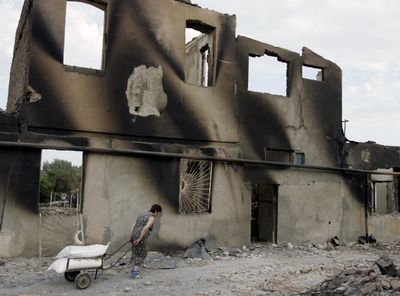Condition on ground belies Russian report

TSKHINVALI, Georgia – As Russian troops pounded through Georgia last week, the Kremlin and its allies repeatedly pointed to one justification above all others: The Georgian military had destroyed the city of Tskhinvali.
Russian politicians and their partners in Tskhinvali, the capital of the breakaway region South Ossetia, said that when Georgian forces tried to seize control of the city and the surrounding area, the physical damage was comparable to Stalingrad and the killings similar to the Holocaust.
But a trip to the city on Sunday, without official minders, revealed a very different picture. While it was clear there had been heavy fighting – missiles knocked holes in walls, and bombs tore away rooftops – almost all the buildings seen in an afternoon driving around Tskhinvali were still standing.
Russian-backed leaders in South Ossetia have said that 2,100 people died in fighting in Tskhinvali and nearby villages. But a doctor at the city’s main hospital, the only one open during the battles that began late on Aug. 7, said the facility recorded 40 deaths.
The discrepancy between the numbers at Tskhinvali’s main hospital and the rhetoric of Russian and South Ossetian leaders raises serious questions about the veracity of the Kremlin’s version of events. Russian Prime Minister Vladimir Putin and other senior officials in Moscow have said the Georgians were guilty of “genocide,” prompting their forces to push Georgia’s military out of South Ossetia – in a barrage of bombing runs and tanks blasts – and march southeast toward the Georgian capital, Tbilisi, stopping only 25 miles away.
That explanation, that Russians were saving South Ossetians from total annihilation, undergirded Moscow’s rationale for the invasion.
Georgia’s leadership maintains the war was launched by the Kremlin because of longstanding resentment about the former Soviet republic’s close ties with the West.
Since Russian troops occupied much of Georgia last week, Kremlin officials have suggested strongly that both South Ossetia and its fellow rebel region, Abkhazia, should gain independence from Tbilisi.
A senior member of Russia’s parliament, Konstantin Zatulin, was in Tskhinvali on Sunday. “We need to recognize reality,” he said, meaning that South Ossetia should secede from Georgia.
The difference between Russian officials’ description of Tskhinvali and the facts on the ground are profound.
Col. Gen Anatoly Nogovitsyn, the deputy head of the Russian military’s general staff, said last Tuesday that “Tskhinvali doesn’t exist, it’s like Stalingrad was after the war.”
But in fact, the city still does exist. While there was extensive damage to some structures, most buildings had front doors on their hinges and standing walls. For every building charred by explosions – the Georgians are accused of using multiple rocket launcher systems – there were others on tree-lined streets that looked untouched.
One government center was hollowed out by blasts, but the one next to it teemed with workers.
While the city was still teetering from the violence, families sat on benches in front of their homes and ate fruit. Many talked about the Georgian incursion on Aug. 7, and the Russian units that then streamed across Georgia’s border to beat them back.
“There were Georgian tanks on each street,” said Givi Tsekhov, who was walking in front of his apartment building. “But then the Russians came.”
Down the road from Tskhinvali, in Georgian areas now occupied by Russian troops, entire towns were almost completely empty and a few bodies were splayed on the side of the road.